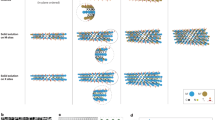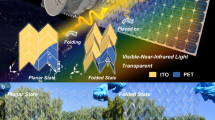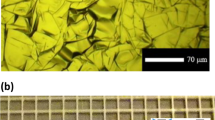Abstract
Dynamic control of electromagnetic wave jamming is a notable technological challenge for protecting electronic devices working at gigahertz frequencies. Foam materials can adjust the reflection and absorption of microwaves, enabling a tunable electromagnetic interference shielding capability, but their thickness of several millimetres hinders their application in integrated electronics. Here we show a method for modulating the reflection and absorption of incident electromagnetic waves using various submicrometre-thick MXene thin films. The reversible tunability of electromagnetic interference shielding effectiveness is realized by electrochemically driven ion intercalation and de-intercalation; this results in charge transfer efficiency with different electrolytes, accompanied by expansion and shrinkage of the MXene layer spacing. We finally demonstrate an irreversible electromagnetic interference shielding alertor through electrochemical oxidation of MXene films. In contrast with static electromagnetic interference shielding, our method offers opportunities to achieve active modulation that can adapt to demanding environments.
This is a preview of subscription content, access via your institution
Access options
Access Nature and 54 other Nature Portfolio journals
Get Nature+, our best-value online-access subscription
$29.99 / 30 days
cancel any time
Subscribe to this journal
Receive 12 print issues and online access
$259.00 per year
only $21.58 per issue
Buy this article
- Purchase on Springer Link
- Instant access to full article PDF
Prices may be subject to local taxes which are calculated during checkout




Similar content being viewed by others
Data availability
All relevant data are available from the authors on reasonable request, and/or are included within the manuscript and its Supplementary Information. Source data are provided with this paper.
References
Ergoktas, M. S. et al. Multispectral graphene-based electro-optical surfaces with reversible tunability from visible to microwave wavelengths. Nat. Photon. 15, 493–498 (2021).
Zhang, X. A. et al. Dynamic gating of infrared radiation in a textile. Science 363, 619–623 (2019).
Ergoktas, M. S. et al. Topological engineering of terahertz light using electrically tunable exceptional point singularities. Science 376, 184–188 (2022).
Peng, J. et al. Scalable electrochromic nanopixels using plasmonics. Sci. Adv. 5, eaaw2205 (2019).
Xu, J., Mandal, J. & Raman, A. P. Broadband directional control of thermal emission. Science 372, 393–397 (2021).
Dyachenko, P. N. et al. Controlling thermal emission with refractory epsilon-near-zero metamaterials via topological transitions. Nat. Commun. 7, 11809 (2016).
Han, M. et al. Anisotropic MXene aerogels with a mechanically tunable ratio of electromagnetic wave reflection to absorption. Adv. Opt. Mater. 7, 1900267 (2019).
Qiu, L., Li, D. & Cheng, H.-M. Structural control of graphene-based materials for unprecedented performance. ACS Nano 12, 5085–5092 (2018).
Liu, W. et al. Graphene charge-injection photodetectors. Nat. Electron. 5, 281–288 (2022).
Inoue, T., De Zoysa, M., Asano, T. & Noda, S. Realization of dynamic thermal emission control. Nat. Mater. 13, 928–931 (2014).
Low, T. et al. Polaritons in layered two-dimensional materials. Nat. Mater. 16, 182–194 (2017).
Fang, Y., Ge, Y., Wang, C. & Zhang, H. Mid-infrared photonics using 2D materials: status and challenges. Laser Photon. Rev. 14, 1900098 (2020).
Balci, O., Polat, E. O., Kakenov, N. & Kocabas, C. Graphene-enabled electrically switchable radar-absorbing surfaces. Nat. Commun. 6, 6628 (2015).
VahidMohammadi, A., Rosen, J. & Gogotsi, Y. The world of two-dimensional carbides and nitrides (MXenes). Science 372, eabf1581 (2021).
Shahzad, F. et al. Electromagnetic interference shielding with 2D transition metal carbides (MXenes). Science 353, 1137–1140 (2016).
Iqbal, A. et al. Anomalous absorption of electromagnetic waves by 2D transition metal carbonitride Ti3CNTx (MXene). Science 369, 446–450 (2020).
Kamysbayev, V. et al. Covalent surface modifications and superconductivity of two-dimensional metal carbide MXenes. Science 369, 979–983 (2020).
Anasori, B., Lukatskaya, M. R. & Gogotsi, Y. 2D metal carbides and nitrides (MXenes) for energy storage. Nat. Rev. Mater. 2, 16098 (2017).
Lukatskaya, M. R. et al. Ultra-high-rate pseudocapacitive energy storage in two-dimensional transition metal carbides. Nat. Energy 2, 17105 (2017).
VahidMohammadi, A., Mojtabavi, M., Caffrey, N. M., Wanunu, M. & Beidaghi, M. Assembling 2D MXenes into highly stable pseudocapacitive electrodes with high power and energy densities. Adv. Mater. 31, 1806931 (2019).
Fleischmann, S. et al. Continuous transition from double-layer to Faradaic charge storage in confined electrolytes. Nat. Energy 7, 222–228 (2022).
Wang, X. et al. Surface redox pseudocapacitance of partially oxidized titanium carbide MXene in water-in-salt electrolyte. ACS Energy Lett. 7, 30–35 (2021).
Simon, P. & Gogotsi, Y. Perspectives for electrochemical capacitors and related devices. Nat. Mater. 19, 1151–1163 (2020).
Zhao, S. et al. Flexible Nb4C3Tx film with large interlayer spacing for high‐performance supercapacitors. Adv. Func. Mater. 30, 2000815 (2020).
Wang, X. et al. Titanium carbide MXene shows an electrochemical anomaly in water-in-salt electrolytes. ACS Nano 15, 15274–15284 (2021).
Han, M. et al. Beyond Ti3C2Tx: MXenes for electromagnetic interference shielding. ACS Nano 14, 5008–5016 (2020).
Mu, X. et al. Revealing the pseudo‐intercalation charge storage mechanism of MXenes in acidic electrolyte. Adv. Func. Mater. 29, 1902953 (2019).
Sarycheva, A. & Gogotsi, Y. Raman spectroscopy analysis of the structure and surface chemistry of Ti3C2Tx MXene. Chem. Mater. 32, 3480–3488 (2020).
Tang, J. et al. Tuning the electrochemical performance of titanium carbide MXene by controllable in situ anodic oxidation. Angew. Chem. Int. Ed. 131, 18013–18019 (2019).
Gogotsi, Y. & Anasori, B. The rise of MXenes. ACS Nano 13, 8491–8494 (2019).
Che, R. C., Peng, L. M., Duan, X. F., Chen, Q. & Liang, X. L. Microwave absorption enhancement and complex permittivity and permeability of Fe encapsulated within carbon nanotubes. Adv. Mater. 16, 401–405 (2004).
Sun, H. et al. Cross-stacking aligned carbon-nanotube films to tune microwave absorption frequencies and increase absorption intensities. Adv. Mater. 26, 8120–8125 (2014).
Acknowledgements
This work was supported by the US National Science Foundation (grants ECCS-2034114 and DMR-2041050; Y.G.) and Murata Manufacturing (Japan). X-ray diffraction analysis was performed using instruments in the Materials Characterization Core at Drexel University.
Author information
Authors and Affiliations
Contributions
M.H. and Y.G. conceived this study. M.H. and D.Z. designed and performed the shield testing. M.H., D.Z. and B.M. synthesized the MXenes and fabricated the MXene films. C.E.S. synthesized the MAX phases. C.E.S. and D.Z. performed the X-ray diffraction measurements. T.Z. performed the SEM observation. D.Z., R.(J.)W. and K.S. contributed to the Raman investigations. M.H. wrote the manuscript with input from all coauthors under supervision from Y.G.
Corresponding author
Ethics declarations
Competing interests
The work is subjected to a patent application (#63/366,852) by M.H., Y.G. and D.Z. The authors declare no other competing interests.
Peer review
Peer review information
Nature Nanotechnology thanks Majid Beidaghi and the other, anonymous, reviewer(s) for their contribution to the peer review of this work.
Additional information
Publisher’s note Springer Nature remains neutral with regard to jurisdictional claims in published maps and institutional affiliations.
Supplementary information
Supplementary Information
Supplementary Table 1 and Figs. 1–12.
Supplementary Video 1
Active EMI shielding change of the V2CTx film.
Supplementary Video 2
Active d-spacing change of the V2CTx film.
Source data
Source Data Fig. 1
Statistical source data and image.
Source Data Fig. 2
Statistical source data.
Source Data Fig. 3
Statistical source data.
Source Data Fig. 4
Statistical source data.
Rights and permissions
Springer Nature or its licensor (e.g. a society or other partner) holds exclusive rights to this article under a publishing agreement with the author(s) or other rightsholder(s); author self-archiving of the accepted manuscript version of this article is solely governed by the terms of such publishing agreement and applicable law.
About this article
Cite this article
Han, M., Zhang, D., Shuck, C.E. et al. Electrochemically modulated interaction of MXenes with microwaves. Nat. Nanotechnol. 18, 373–379 (2023). https://doi.org/10.1038/s41565-022-01308-9
Received:
Accepted:
Published:
Issue Date:
DOI: https://doi.org/10.1038/s41565-022-01308-9
This article is cited by
-
MXenes for multispectral electromagnetic shielding
Nature Reviews Electrical Engineering (2024)
-
High-strain-sensitive dynamically adjustable electromagnetic interference shielding elastomer with pre-linked nickel chains
Science China Materials (2024)
-
Sandwiched MXene/polyimide composite foams for multiscale microwave absorption
Science China Materials (2024)
-
Two-Dimensional Cr5Te8@Graphite Heterostructure for Efficient Electromagnetic Microwave Absorption
Nano-Micro Letters (2024)
-
Direct ink writing of multifunctional gratings with gel-like MXene/norepinephrine ink for dynamic electromagnetic interference shielding and patterned Joule heating
Nano Research (2024)



